How Brigus Gold Is Finally Making the Grade
You wouldn't use chopsticks as crutches or put a saddle on a Chihuahua. And a dentist wouldn't drill a cavity with a miner's exploration drill. In order to tackle any endeavor efficiently, one's equipment and approach must be sized for the task at hand.
I went back to Brigus Gold's (ASE: BRD) Black Fox mine complex near Timmins, Ontario last week for a second visit -- precisely one year after my first time at the site. Earlier attempts to ramp up underground gold production at Black Fox encountered a barrage of delays and operational misfires, resulting in significant weakness in the shares.
But since December 2011, when mine manager Marc Bilodeau stepped onto the scene, the operation has executed a critical about-face by prioritizing grade control and right-sizing of operations over ore tonnage. Brigus hired four mine geologists and a production coordinator, right-sized some of its underground equipment, and took other steps to support a substantially revamped approach to the underground operation. The average underground grade has already doubled from 3 grams per ton to 6 gpt in the fourth quarter of 2011, with the task ahead to ramp up volume using the methods now set into motion. In impressively short order, Bilodeau and his team have achieved the lion's share of the operational turnaround for which investors had patiently pined.
A complex and variable gold deposit
The Black Fox mine comprises two distinct ore zones that begged distinct approaches to mining activity. The West Zone is a "shear zone," where gold mineralization associated with vertical deformations in the host rock offers clearer visual guidance to miners and "beat geologists" navigating their daily ore excavations. The East Zone represents a "folded" geological structure that adds a measure of complexity and requires careful 3-D modeling to precisely guide mining activity.
Particularly in the East Zone, Bilodeau modified the mining approach to more precisely track narrow veins of mineralization through the orebody. Our tour of the underground mine took us to two distinct levels of the East Zone, and on the second stop we surveyed one of the new production stopes created this year under the revised approach (see the following two photographs).
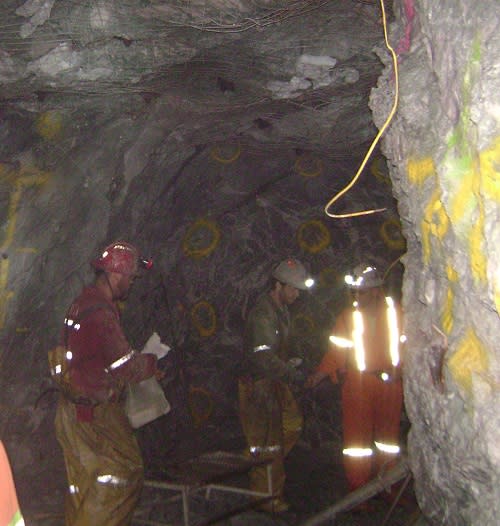
This active production stope, developed in 2012, is more narrow in scale than others in the mine to match the width of the mineralized structures that particularly characterize the mine's East Zone. Photograph by Christopher Barker.
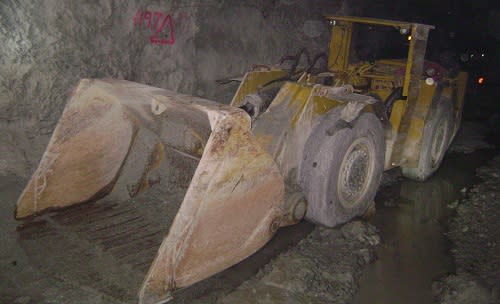
This smaller scoop tram, manufactured by Atlas Copco, was recently added to the underground fleet as a right-sized complement to the newly revised mining methods. Photograph by Christopher Barker.
Making the grade by blending grades
Brigus' refreshed underground methodology also targets the availability of some 30 separate production stopes at any given time. The idea is not to mine all those stopes at once, but rather to grow more selective in mining whichever combination of stopes offers the best approximation of the targeted average gold grade of between 6 gpt and 7 gpt. You see, even though an orebody might average 6 gpt, realized grades -- from one day to the next, and from one stope to the next -- can vary wildly between the cut-off grade of 2.54 gpt and hgihs of 20 grams per ton or higher. Ultimately, a well-honed mining operation is as much about blending and grade control as it is about efficient excavation and milling.
Of the handful of active production stopes we visited during the tour, two of them were running in the neighborhood of 20 gpt (and contained visible gold -- see below). Incidentally, that pleasant fact may have contributed to Bilodeau's confidence that his team will still meet Brigus' second-quarter production target despite a multiday outage related to nearby wildfires last month. Brigus is looking for 18,000 to 21,000 ounces of gold production for the second quarter, with further volume improvements to follow on the path toward steady-state production rates by early 2013.
There can be no doubt: Black Fox is on the gold!
Rapid-fire field assays, together with careful geological mapping and interpretation, are critical means of ensuring that production effectively targets the gold-bearing ore. But nothing can confirm the presence of economic gold grades faster than a sighting of visible gold -- particularly where those sightings are widespread and prevalent. Upon examining Pretium Resources' (NYS: PVG) remarkable visible gold showings in drill cores from its Valley of the Kings deposit in British Columbia, for example, I resolved right then and there that I simply had to own those shares.
On this particular visit to the Black Fox mine, I observed ample visible gold in multiple areas of the deposit -- and with surprising frequency. I've included a few photographs of visible gold below, but these are merely a sampling. As I mentioned above, two of these occurrences of visible gold corresponded to active production stopes yielding current grades in the neighborhood of 20 gpt. Atop the mountain of corroborating due diligence I've conducted on this company, the multiple occurrences of visible gold that I witnessed at Black Fox shine yet another beam of glistening light on the quality of this golden orebody.
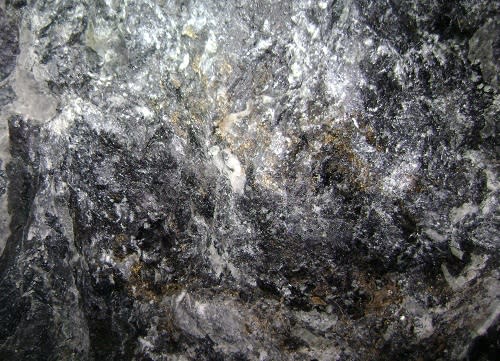
This segment of a ramp wall, situated across from an active production stope in Level 9674 East, shows a surface area roughly the size of an iPad featuring pervasive visible gold. Photograph by Christopher Barker.
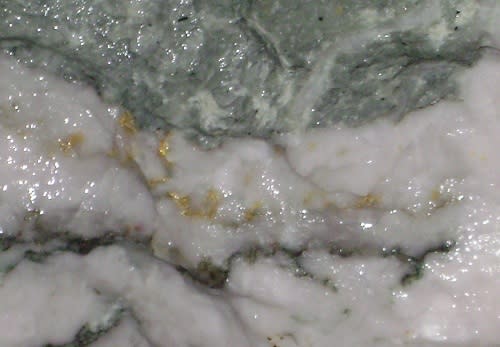
This detail of an active production stope in Level 9660 East, showing an area about the size of your hand, shows a more orderly deposition of gold through a contiguous, minute fissure in the quartz host rock. Photograph by Christopher Barker.
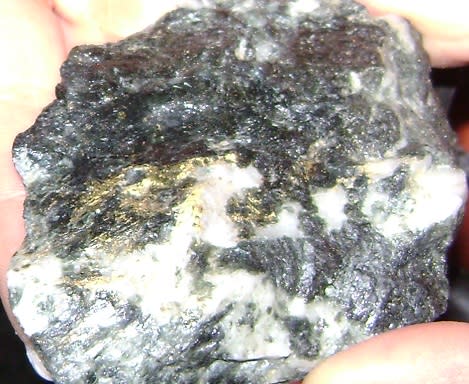
This gold-rich gem was picked from the ground by a member of Brigus' staff in Level 9686 West, and then returned to the "muck pile" to make its way to the mill for processing. Photograph by Christopher Barker.
Brigus Gold's enterprise value corresponds to only $229 for each measured and indicated ounce of gold at Black Fox. That's less than Yamana Gold (NYS: AUY) just offered for Extorre Gold (NYS: XG) based upon corresponding ounces at Cerro Moro! I think Extorre is a terrific get for Yamana, and these sorts of comparisons are seldom simple, but the deal does provide a timely marker to underscore the bargain valuation of Brigus Gold's shares. As my readers know, I consider Primero Mining (NYS: PPP) a similar outlier on the scale of ultra-deep bargains in gold. I have patiently maintained my bullish CAPScall on Brigus Gold since late-2010, and I strongly encourage Fools to take a very close look at the far superior entry price available today. To track all my coverage of Brigus Gold, as well as the gold and silver miners at large, please bookmark my article list or follow me on Twitter.
Add Brigus Gold to My Watchlist
Add Pretium Resources to My Watchlist
Add Primero Mining to My Watchlist
Add Extorre Gold to My Watchlist
Add Yamana Gold to My Watchlist
At the time thisarticle was published Fool contributorChristopher Barkercan be foundblogging activelyand acting Foolishly within the CAPS community under the usernameTMFSinchiruna. Hetweets. He owns shares of Brigus Gold, Pretium Resources, and Primero Mining. Travel and lodging to attend the mine tour were provided by Brigus Gold. The Motley Fool owns shares of Primero Mining New. The Motley Fool has adisclosure policy. We Fools may not all hold the same opinions, but we all believe thatconsidering a diverse range of insights makes us better investors. Try any of our Foolish newsletter services free for 30 days.
Copyright © 1995 - 2012 The Motley Fool, LLC. All rights reserved. The Motley Fool has a disclosure policy.

